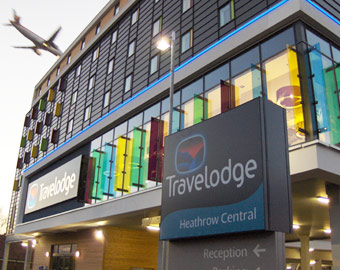Brand survivors
Every supplier with miles on the clock knows the feeling. You check into a mid-market hotel on the fringes of a nothing town, chosen for its convenience for your client’s HQ.
But your stay turns out to be brief. Maybe 40 or 50 minutes. Long enough for that sinking sensation to take hold as you realise this space is not one you wish to wake up in before going out to run a three-day workshop or a training programme, nor to come back to at night, alone, with just the outputs of the day to organise, ready for the next.
The last time that happened to me was a couple of years back in a Travelodge in Northampton. I had a bunch of reasons for abruptly checking out – windows that didn’t open, grubby surfaces, nasty toiletries, poor-quality bedding – but among them was the fact that I could. I was at liberty, as a paying customer, to settle up for the first night booked, cancel the others and give my reasons to the front desk. “Well, it’s mostly a place for builders,” was the memorable response.
Today, many of our mid-market hotel chains are gearing up for a very different kind of paying customer. I just hope, for everyone’s sake, that standards have risen a bit since my last encounter with the category – because, while these new customers will certainly be paying, they will not be permitted to leave anytime soon. If flaws exist within those circa 18 square metres of mostly-bed space, they will have plenty of time to expose them.
Quarantine hotel. There’s an oxymoron for you. A place where security guards and perimeter fencing are there to keep people in, not out. Where non-opening windows are a selling point. Where customers check in as reluctant detainees and check out 11 days later as survivors.
Brand dilemma
I find myself wondering how it must feel to be the CMO of one of these hotel brands right now. All the classical principles of the discipline are inverted. Normally, the competent marketer works back from customer needs and desires with the objective of reliably meeting them at an acceptable price and, if possible, going on to surprise and delight.
Here, your customers – do you still call them guests? – are obliged to pay a hefty, fixed sum upfront but would really rather not be the recipient of your hospitality at all. Meanwhile, the real customer – not the one paying but the one coercing – has needs of a very different kind: security, efficiency, discretion. Which do you prioritise?
Those are the short-term questions, but a CMO will always be thinking about longer-term brand health, too. What are the possible lasting effects on the brand of those negative quarantine associations? How does it play if the TV news constantly regurgitates images of weary arrivals being escorted out of the bus by beefy security right under your ‘welcome’ sign and your big, unmissable logo?
Marketers are only human, and many will be tempted to look on the optimistic side. A majority of the UK population backs enforced quarantine measures and frowns on anyone who dares to travel right now, so it’s just possible your brand will be associated with warm feelings of nationwide community protection.

The snag here is that this scolding viewpoint is likely to be prevalent among your own employees. Without renewed brand engagement effort – rarely a strong point for marketers – might they let their disdain show, and treat these customers more like inmates?
That’s not an entirely theoretical question. You only have to look at how certain staff in related categories have gained a taste for the over-zealous enforcement of government diktats – like the train guard I recently heard belittling and berating those who allowed their mask to slip under their nose. In near-empty carriages.
Then there is the word-of-mouth aspect when people leave. No matter how diligent your team have been, the people who head onwards from your properties are unlikely to wax lyrical about their days and nights in captivity. The gripes, flaws and constraints are likely to be topmost in their mind and, for a while, they won’t have much else to talk about.
Again, our CMO might look on the optimistic side: the numbers are very small; there won’t be many out there spreading their ‘nightmare’ stories. But these individual quarantine experiences are small in the same way that Handforth Parish Council is small: if the story is interesting or extreme or crazy enough, it will get an audience of, well, pretty much everybody.
Mitigating negative consequences
From 11,000 miles away I can get a feel for the quarantine experience in New Zealand and Australia. It’s not all bad. But it’s the bad stuff that you remember best and share most.
Like this: the Sydney property that was so dirty that 400 detainees were marched out one night to a rival hotel, and the brand was struck off the government approved list. A Travelodge, as it happens. Or there’s the guy who was only ever served bread for breakfast when he wanted toast and took to ironing it to get it closer to the warm, crispy thing he craved. Surprise and delight right there – but in the reading and the gleeful sharing, not the brand experience itself.
I can think of three possible actions our imagined CMO might take to mitigate the negative brand consequences of this government-derived business, working from sound marketing principles.
The first is to throw every resource at your disposal at making quarantine stays unexpectedly acceptable, so that a little good social media might emerge to balance the bad. Touches like daily fresh fruit and flowers, judging from posts from Down Under, make an enormous difference. Or you could strive to put some basic exercise equipment in each room. Working for you here is the fact of low incoming expectations. Working against you, conceivably, will be your CFO, who will abhor the erosion of profits.
The second option is to take a brand architecture approach to the problem – especially if you see quarantine as a medium- or long-term reality. Carve out a sub-brand for your quarantine service, clearly separate from the main brand, and restrict it to just your airport properties offering the arrangement.
The third way is to advise the board to decline this source of business altogether, with the objective of keeping your brand associations intact for the longer term. That’s easy for me to say as an outside supplier; tougher when you’re on the inside desperate for any kind of revenue after a year of earning close to zilch.
I can empathise with that feeling. I can imagine the discomfort of that dilemma. But I’d like to think that, if I were in that CMO hotseat right now, it’s the purist, farsighted, brand-first option number three that I would want to most seriously check out.
